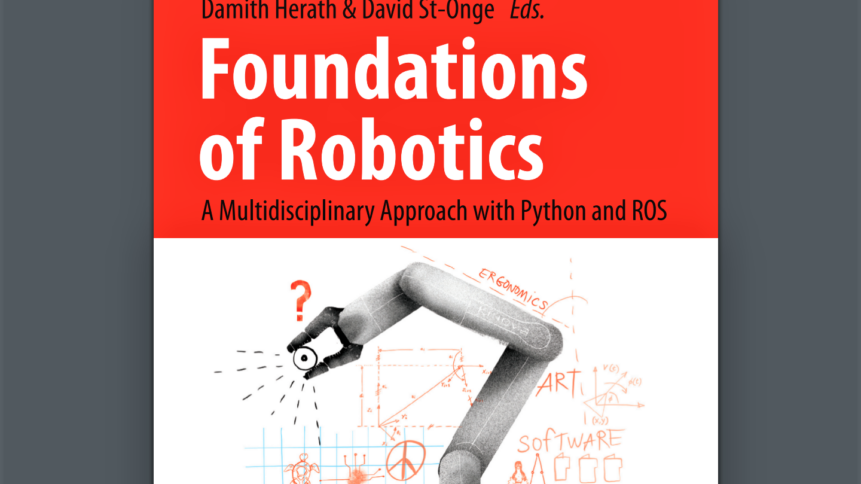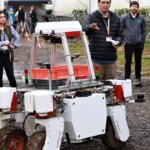Getting to grips with robotics – Kinova funds open access guide

Noticing the rise of the robots is one thing, but having the technical know-how and applications insight to leverage those gains for your industry or business is something else. Today, robotics has burst out of its manufacturing niche, with examples being found more broadly in hospitals, restaurants, across the supply chain, and even in some of our homes. To get up to speed on the opportunities, it’d be great to simply grab a user manual on robotics.
User manual on robotics
Better still if that practical guide was pitched to enthusiasts across all disciplines. And the good news is that technical publishing house Springer has released such a title on robotics. “Robotics is no longer the exclusive bailiwick of engineers, physicians or research groups,” write Damith Herath and David St-Onge, editors of ‘Foundations of Robotics: A Multidisciplinary Approach with Python and ROS’ – a 549-page exploration of building robot-powered solutions.
What’s more, thanks to a contribution from robot maker Kinova – headquartered in Québec, Canada – the English version of the book is now free to access. This makes it even easier to dive in and start discovering how robots can benefit your business operations and customer solutions. To get up to speed on the practicalities of doing so, the Foundations of Robotics group provides a companion GitHub public repository, which includes all code and technical documentation for the various projects.
To set the scene, the book begins with a review of the rich history of robots, before opening up the discussion to include details on designing and programming devices. The editors recognize that the amount of knowledge needed to deploy a robotic system can sometimes feel overwhelming. But they also point out that many problems have already been solved by others already working in the field and users can benefit from decades of public research.
Robot operating system (ROS)
The book includes a chapter dedicated to the so-called ‘robot operating system’ (ROS). This section equips readers with the knowledge to run and launch ROS nodes and packages, as well as clarifying details on the message structure, topics, and services. And gaining familiarity with ROS will naturally help any readers making the transition to ROS-I, which brings the best of ROS to industrial-scale robotics.
Perception tools within ROS include algorithms for simultaneous localization and mapping (SLAM). The code takes feeds from either 2D LiDAR, 3D LiDAR, stereo camera, or single camera hardware and renders a map of the environment being explored by the robot. The routines allow mobile machines to be deployed in scenarios that lack GPS coverage, or where signals may be intermittent. Given that ROS is predominantly run on Linux, the chapter also highlights various Linux tools that will be useful for roboticists and ROS developers.
To test their algorithms, developers rely routinely on simulations. As the authors point out, digital solutions also make it possible to train artificial intelligence systems ahead of deploying systems in the real world. The book includes notes on Gazebo simulator, which provides a great starting point for beginners thanks to its open-source format and community support.
Sensors and actuators
Part two of the book covers sensors and actuators, digging into how robots feel and move. The topic’s contributors — Jiefei Wang and Damith Herath, robotics experts based in Canberra, Australia – also introduce useful terminology. This includes ‘state’, which refers to the robot’s current configuration. “The robot state space is all possible states a robot could be in. Observable states are the set of fully visible states to the robot, while other states might be hidden or partly visible to the robot. Such states are called partially observable states,” add the experts.
“Sensors have been around for a long time. By strategically placing them into a machine, one can achieve an unprecedented amount of feedback from a machine to allow better control and operation precision,” comments Vitaliy Khomko – a Vision Application Developer based at Kinova. He started his robotics journey back in 2015 and points to a noticeable shift from simple automated equipment controlled by human experts to the emergence of very efficient autonomous machines capable of making decisions
Adding to its appeal as a practical user manual on robotics, the book does a great job of describing the common sensors used by developers. These include light-sensitive detectors and ultrasonic devices, as well as range-finding modules, affordable cameras, and encoders for recording movement metrics.
Robot ethics
As well as tackling the hardware and coding elements, the title also has a chapter dedicated to robot ethics and ethical design considerations. The text is written by Dylan Cawthorne, who’s based at The Maersk Mc-Kinney Moller Institute. Research carried out at the Danish lab has spawned a cluster of robotics in Southern Denmark, featuring more than 130 robotic companies, including Universal Robots (UR) and Mobile Industrial Robots (MiR).
Ethical considerations include understanding the long-term impact of robots on peoples’ physical, psychological, and material welfare. For example, Cawthorne draws attention to the difference in deploying technology in a country where workers are likely to be retrained to build or collaborate with robots versus a scenario where people become redundant. He encourages readers to be responsible technologists and make well-reasoned choices about the capabilities that robots should have.










